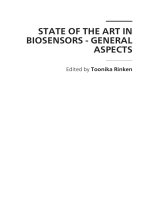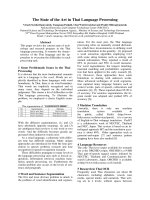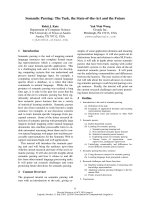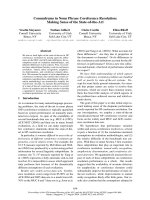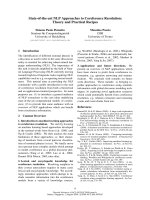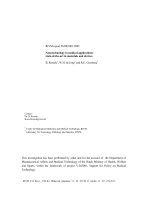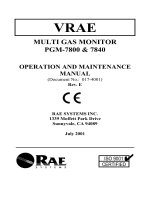STATE OF THE ART IN BIOSENSORS - ENVIRONMENTAL AND MEDICAL APPLICATIONS potx
Bạn đang xem bản rút gọn của tài liệu. Xem và tải ngay bản đầy đủ của tài liệu tại đây (16.49 MB, 360 trang )
STATE OF THE ART IN
BIOSENSORS - GENERAL
ASPECTS
Edited by Toonika Rinken
State of the Art in Biosensors - General Aspects
/>Edited by Toonika Rinken
Contributors
Tatiana Duque Martins, Diogo Lopes, Henrique Camargo, Antonio Ribeiro, Paulo Costa-Filho, Hannah Cavalcante,
Zihni Onur Onur Uygun, Hilmiye Deniz Deniz Ertuğrul, shengbo sang, Wendong Zhang, Yuan Zhao, Kazuo Nakazato,
Christopher Bystroff, BP Rao, CheolGi Kim, Antonio Arnau, María-Isabel Rocha-Gaso, Yolanda Jiménez, Laurent Alain
Francis, Pere Miribel-Català, Jordi Colomer-Farrarons, Jaime Punter Villagrasa, Joanna Cabaj, Jesús Eduardo Lugo,
Dominique Barchiesi, Sameh Kessentini, Shunichi Uchiyama, Toonika Rinken
Published by InTech
Janeza Trdine 9, 51000 Rijeka, Croatia
Copyright © 2013 InTech
All chapters are Open Access distributed under the Creative Commons Attribution 3.0 license, which allows users to
download, copy and build upon published articles even for commercial purposes, as long as the author and publisher
are properly credited, which ensures maximum dissemination and a wider impact of our publications. After this work
has been published by InTech, authors have the right to republish it, in whole or part, in any publication of which they
are the author, and to make other personal use of the work. Any republication, referencing or personal use of the
work must explicitly identify the original source.
Notice
Statements and opinions expressed in the chapters are these of the individual contributors and not necessarily those
of the editors or publisher. No responsibility is accepted for the accuracy of information contained in the published
chapters. The publisher assumes no responsibility for any damage or injury to persons or property arising out of the
use of any materials, instructions, methods or ideas contained in the book.
Publishing Process Manager Dejan Grgur
Technical Editor InTech DTP team
Cover InTech Design team
First published March, 2013
Printed in Croatia
A free online edition of this book is available at www.intechopen.com
Additional hard copies can be obtained from
State of the Art in Biosensors - General Aspects, Edited by Toonika Rinken
p. cm.
ISBN 978-953-51-1004-0
free online editions of InTech
Books and Journals can be found at
www.intechopen.com
Contents
Preface VII
Section 1 Biorecognition Techniques 1
Chapter 1 GFP-Based Biosensors 3
Donna E. Crone, Yao-Ming Huang, Derek J. Pitman, Christian
Schenkelberg, Keith Fraser, Stephen Macari and Christopher
Bystroff
Chapter 2 Layered Biosensor Construction 37
Joanna Cabaj and Jadwiga Sołoducho
Chapter 3 Polymers for Biosensors Construction 67
Xiuyun Wang and Shunichi Uchiyama
Section 2 Signal Transduction Methods 87
Chapter 4 Review on the Design Art of Biosensors 89
Shengbo Sang, Wendong Zhang and Yuan Zhao
Chapter 5 New Insights on Optical Biosensors: Techniques, Construction
and Application 111
Tatiana Duque Martins, Antonio Carlos Chaves Ribeiro, Henrique
Santiago de Camargo, Paulo Alves da Costa Filho, Hannah Paula
Mesquita Cavalcante and Diogo Lopes Dias
Chapter 6 Porous Silicon Biosensors 141
M. B. de la Mora, M. Ocampo, R. Doti, J. E. Lugo and J. Faubert
Chapter 7 Potentiometric, Amperometric, and Impedimetric CMOS
Biosensor Array 163
Kazuo Nakazato
Chapter 8 Impedimetric Biosensors for Label-Free and Enzymless
Detection 179
Hilmiye Deniz ErtuğruL and Zihni Onur Uygun
Chapter 9 Novel Planar Hall Sensor for Biomedical Diagnosing
Lab-on-a-Chip 197
Tran Quang Hung, Dong Young Kim, B. Parvatheeswara Rao and
CheolGi Kim
Chapter 10 Bioelectronics for Amperometric Biosensors 241
Jaime Punter Villagrasa, Jordi Colomer-Farrarons and Pere Ll.
Miribel
Section 3 Biosensor Signal Analysis 275
Chapter 11 Love Wave Biosensors: A Review 277
María Isabel Gaso Rocha, Yolanda Jiménez, Francis A. Laurent and
Antonio Arnau
Chapter 12 Nanostructured Biosensors: Influence of Adhesion Layer,
Roughness and Size on the LSPR: A Parametric Study 311
Sameh Kessentini and Dominique Barchiesi
Chapter 13 Calibrating Biosensors in Flow-Through Set-Ups: Studies with
Glucose Optrodes 331
K. Kivirand, M. Kagan and T. Rinken
ContentsVI
Preface
Biosensors, constituting cheap and rapid alternate to traditional analytical equipment, have
been in the focus of scientific research already for 50 years, since the initial biosensor con‐
cept was proposed in 1962 by Clark and Lyons. Throughout this half century, the number of
studies dedicated to the research and applications of biosensor – based techniques is exceed‐
ing 200,000; including those over 14,000 published in 2012.
The present book is focused on the general aspects of state of the art in biosensor technolo‐
gies. It is composed of 13 chapters written by 44 authors and is divided into three sections,
which correspond to the “three whales” of bio-sensing and match to the three parts of the
word BIO-SEN-SOR. The first section of the book is focused on the principles and techni‐
ques of bio-selective recognition of different compounds and the immobilization of bio-se‐
lective materials; the second on the transduction methods of the signals of bio-recognition
reactions and the third on the signal analysis and calibration of biosensors or how to get the
most out of collected information. Regarding the first sections as BIO and SEN accordingly,
the last section SOR could be considered as the “Smart Organization of Results”.
The division of the chapters into sections is based on the major focus of these studies and is
not limiting the topics handled – valuable results and new ideas of different aspects of bio‐
sensor technology are found in all papers. I would like to express my appreciation and grati‐
tude to all authors and the publishing company for their commitment and cooperation and
wish them success in their forthcoming activities.
Dr. Toonika Rinken,
Institute of Chemistry,
University of Tartu,
Estonia
Section 1
Biorecognition Techniques
Chapter 1
GFP-Based Biosensors
Donna E. Crone, Yao-Ming Huang, Derek J. Pitman,
Christian Schenkelberg, Keith Fraser,
Stephen Macari and Christopher Bystroff
Additional information is available at the end of the chapter
/>1. Introduction
Green fluorescent protein (GFP) is a 27 kD protein consisting of 238 amino acid residues [1].
GFP was first identified in the aquatic jellyfish Aequorea victoria by Osamu Shimomura et al.
in 1961 while studying aequorin, a Ca
2+
-activated photoprotein.Aequorin and GFP are local‐
ized in the light organs of A. victoria and GFP was accidentally discovered when the energy
of the blue light emitted by aequorin excited GFP to emit green light.Unlike most fluores‐
cent proteins which contain chromophores distinct from the amino acid sequence of the pro‐
tein, the chromophore of GFP is internally generated by a reaction involving three amino
acid residues [2]. This unique property allows GFP to be easily cloned into numerous bio‐
logical systems, both prokaryotic and eukaryotic, which has paved the way for its utilisation
in a variety of biological applications, most notably in biosensing.
1.1. The three dimensional structure
The molecular structure of GFP was first determined in 1996 using X-ray crystallography
[1].One of the most obvious features of its tertiary structure is a beta-barrel composed of 11
mostly-antiparallel beta strands. The molecular structure of GFP is illustrated in Figure 1
along with a cartoon representation showing the organization of the secondary structure ele‐
ments that compose the beta barrel.Each beta strand is 9 to 13 residues in length and hydro‐
gen bonds with adjacent beta strands to create an enclosed structure.The bottom of the
barrel contains both termini and two distorted helical crossover segments, and the top has
one short crossover and one distorted helical crossover segment.The beta-barrel (sometimes
referred to as a “beta can” because it contains a central alpha-helical segment) consists of
three anti-parallel three-stranded beta-meander units and a two-stranded beta-hairpin
© 2013 Crone et al.; licensee InTech. This is an open access article distributed under the terms of the Creative
Commons Attribution License ( which permits unrestricted use,
distribution, and reproduction in any medium, provided the original work is properly cited.
(shown in blue, green, and yellow, and red in Figure 1 respectively).The very distorted cen‐
tral alpha helix contains three residues which participate in an auto-catalyzed cyclization/
oxidation chromophore maturation reaction which generates the p-hydroxybenzylidene-imi‐
dazolidone chromophore.In the unfolded state, the chromophore is non-fluorescent, pre‐
sumably because water molecules and molecular oxygen can interact with and quench the
fluorescent signal [3].Therefore, the closed beta barrel structure is essential for fluorescence
by shielding the chromophore from bulk solvent.
Figure 1. Tertiary structure of GFP as determined by x-ray crystallography (PDB code 2B3P).Shown on the bottom is a
cartoon depicting the secondary structure elements, all anti-parallel beta strand pairings except β1 to β6, which is par‐
allel. Numbers indicate the start and end of each secondary structure element.
The interior of the GFP beta barrel is unusually polar.There is an interior cavity filled with
four water molecules on one side of the central helix, while the other side contains a cluster
of hydrophobic side chains which is more typical of a protein core.Several polar side chains
interact with and stabilize the GFP chromophore.Three of these, His148, Thr203, and Ser205,
form hydrogen bonds with the phenolic hydroxyl group of the chromophore.Arg96 and
Gln94 interact with the carbonyl group of the imidazolidone ring. Figure 2 depicts these sta‐
bilizing hydrogen bonding interactions with the chromophore.Additionally, a number of in‐
ternal residues interact with and stabilize Arg96, a side chain that is known to be required
for the maturation of the chromophore.Specifically, Thr62 and Gln183 form hydrogen bonds
with the protonated form of Arg96 stabilizing a buried positive charge within the GFP beta
barrel, which in turn stabilizes a partial negative charge on the carbonyl oxygen of the imi‐
dazolidone ring.
1.2. Thermodynamic and kinetic properties
Wild type GFP has a number of interesting characteristics that can potentially complicate its
applicability to biosensing.One is its tendency to aggregate in the cell, especially when ex‐
pressed in high concentrations. Aggregation is typically caused by exposed hydrophobicity,
which may be due to either the presence of hydrophobic patches on the surface of the protein,
or to low thermostability, or to slow folding.Surface hydrophobic-to-hydrophilic mutations
decrease the aggregation tendency of GFP [4], but some biosensing applications require sur‐
face mutations that may increase aggregation. Most likely, GFP’s low in vivo solubility is due
to its extremely slow folding and unfolding kinetics.Refolding of GFP consists of at least two
observable phases, depending on the variant and the method being used to measure the kinet‐
State of the Art in Biosensors - General Aspects
4
ics.Multi-phase folding kinetics indicates the existence of multiple parallel folding pathways,
some fast and some slow, holding out the hope that engineered GFPs could be made to fold
faster by favoring the faster folding pathway. Indeed, GFP has been engineered to eliminate
the slowest phase of folding, as discussed later in this chapter. For Cycle3, a mutant whose
chromophore matures correctly at 37°C, the kinetic phases range from 10 s
-1
to 10
-2
s
-1
[5] (half-
lives of folding ranging from 0.1 s to 100 s). Although it folds slowly, GFP unfolds extremely
slowly, with a rate of 10
-6
s
-1
(t
1/2
=8 days) in 3.0M GndHCl [6], such that when extrapolated to
0M GndHCl, the theoretical unfolding half-life in on the order of t
1/2
= 22 years.GFP is phenom‐
enally kinetically stable once it is folded to its native state.
Figure 2. Stereo image of the hydrogen bonding patterns of the internal GFP residues with the chromophore (green),
including four crystallographic waters (cyan). Drawn from superfolder GFP, PDB ID 2B3P.
1.3. Maturation of the chromophore
The chromophore of the native GFP structure is generated by an internal, autocatalytic reac‐
tion involving three residues on the interior alpha helix.Cyclization and oxidation of inter‐
nal residues of Ser65, Tyr66, and Gly67, generate a p-hydroxybenzylidene-imidazolidone
chromophore that maximally absorbs light at 395 nm and 475 nm [1].Excitation at either ab‐
sorption peak results in emission of green light at 508 nm.Interestingly, the sidechains of the
chromophore triplet65-SerTyrGly-67 can be mutated to other sidechains without loss of
function. Tyrosine 66 can be mutated to any aromatic sidechain [7].This allows for the syn‐
thesis of numerous variants of GFP that alter the chromophore structure or its surrounding
environment to absorb and emit light at different wavelengths, producing a wide array of
fluorescent protein colors [8].
The three-step mechanism for the spontaneous generation of the chromophore consists of
cyclization, oxidation, and dehydration [9]. Figure 3 illustrates the mechanism, beginning
with the original triplet of amino acids. The slow step in chromophore maturation is the dif‐
fusion of molecular oxygen into the active site of the closed beta barrel (step 3). The posi‐
GFP-Based Biosensors
/>5
tioning of side chains surrounding the chromophore is crucial for stabilizing the
intermediates in the process of chromophore maturation,especially Arg96, which stabilizes
the enolate form of intermediate 1 by forming a salt bridge with the negatively-charged oxy‐
gen atom, and Glu222, which receives protons from the water molecules to cycle between
the protonated and deprotonated states.The two coplanar aromatic rings of the chromo‐
phore adopt the cis conformation across the Tyr66 alpha-beta carbon double bond.Photo‐
bleaching, the light-induced loss of fluorescence, is caused by short wavelength light that
causes the chromophore to isomerize to the trans form, accompanied by distortion of its pla‐
nar geometry and surrounding side chain packing [10].This type of photobleaching appears
to be a slowly reversible process for GFP and other fluorescent proteins.
Figure 3. Mechanism of the maturation of the GFP chromophore. Steps 1-6 include the cyclization and deoxidation
steps while step 7 indicates two possible pathways for the dehydration step. Used with permission from [9]
The two spectral absorbances of the GFP chromophore have been found to be highly sensi‐
tive to pH changes [11].At physiological pH, GFP exhibits maximal absorption at 395 nm
while absorbing lesser amounts of light at 475 nm.However, increasing the pH to about 12.0
causes the maximal absorption of light to occur around 475 nm while diminishing the ab‐
sorption at 395 nm.The two absorption maxima correspond to different protonated states of
the chromophore.The pK
a
for the side chain hydroxyl group of Tyr66 is about 8.1 [12] and
therefore, the maximal absorbance for the neutral chromophore occurs at 395 nm while max‐
imal absorbance occurs at 470 nm for the anionic form of the chromophore.At acidic pHs
lower than 6 or alkaline pHs above 12, fluorescence is diminished as GFP is denatured and
the chromophore is quenched.
1.4. Wavelength variants and FRET
Starting with homologous green and red fluorescent proteins, a rainbow of different-colored
fluorescent proteins have been developed. Mutating Tyr66 of the GFP chromophore to a
tryptophan produces cyan fluorescence, while a histidine mutation produces blue fluores‐
cence. Mutating a threonine on beta strand 10 to a tyrosine introduces a pi-stacking interac‐
tion which produces yellow fluorescence. See [3] for more details. At the other end of the
color spectrum, the coral-derived DsRed fluorescent protein, a structural homolog of GFP,
was diversified into the mFruits library, producing eight fluorescent proteins with emission
maxima ranging from 537 to 610 nm [13]. Far-red fluorescent proteins, which have potential
State of the Art in Biosensors - General Aspects
6
for use in deep tissue imaging due to the penetration of these wavelengths, have been dis‐
covered [14-16], while others have been developed in the lab [17] and even using computa‐
tional approaches [18]. Further enhancement of these wavelength-shifted variants has
improved their biophysical properties and made them available to more applications.
GFP and its derivatives have seen significant use as fluorescent pairs for Förster Resonance
Energy Transfer (FRET) experiments. FRET emission arises when the emission spectrum of
one chromophore overlaps with the excitation spectrum of another chromophore. If the two
chromophores are physically close (on the order of a few nanometers) and in the correct ori‐
entation, then excitation of the first chromophore will excite the second chromophore
through non-radiative energy transfer and produce fluorescence at the second chromo‐
phore's emission wavelength (Figure4). This phenomenon can be used to detect when two
fluorescent proteins (FPs) are within a certain distance, which may be induced by a ligand-
dependent conformational change in a linking domain between the two fluorescent pro‐
teins, or by binding of interacting domains fused to fluorescent proteins. The canonical
pairing for FRET using fluorescent proteins is cyan fluorescent protein (CFP) and yellow flu‐
orescent protein (YFP) [19]; but this pairing has issues concerning overlapping emission
spectra, stability to photobleaching, and sensitivity to the chemical environment. The study
in [20] had the goal of producing a cyan fluorescent protein more suitable for use in FRET
experiments. Other pairings, such as GFP and the the DsRed-based variant mCherry red flu‐
orescent protein, have been proposed as consistent, reliable alternatives [21]. A full review
of the development and usage of fluorescent proteins as tools for FRET can be found in [22].
The genetic and physical ease of use of GFP-derived fluorescent proteins, in conjunction
with their wide range of colors and spectral overlaps, makes them ideal molecules for the
design of FRET-based biosensors.
Figure 4. Illustration of the FRET phenomenon using the traditional CFP/YFP donor/acceptor pairing. a) If the two flu‐
orescent moieties are too far apart, excitation of the donor molecule only produces observable emission from the do‐
nor. b) When in range, excitation of the donor is propagated to the acceptor molecule through non-radiative photon
transfer, and emission from the acceptor is observed.
GFP-Based Biosensors
/>7
1.5. Mutants with improved features
Because of the aforementioned slow folding, low solubility and slow chromophore matura‐
tion, a significant effort has been put forth to improve these properties in GFP. These strat‐
egies range from specific, directed rational mutations based on structural and biophysical
information to fully randomized approaches such as error-prone PCR [23] and DNA shuf‐
fling [24]. By mutating the chromophore residue serine 65 to a threonine (S65T) and phenyl‐
alanine 64 to a leucine (F64L), an “enhanced” GFP (EGFP, gi:27372525) was produced with
the excitation maximum shifted from ultraviolet to blue and with better folding efficiency in
E. coli[25]. Blue excitation is favorable because it matches up with the wavelengths of laser
light used in modern cell sorting machines. Three rounds of DNA shuffling produced a mu‐
tant of GFP termed “cycle3” or GFPuv (gi:1490533) which contains three point mutations at
or near the surface of the protein (F100S, M154T, V164A). This mutant has 16- to 18-fold
brighter fluorescence than wild type GFP, attributed to a reduction of surface hydrophobici‐
ty and, subsequently, aggregation in vivo which prevents chromophore maturation [6].
Combining these sets of mutations produces a “folding reporter” GFP (gi: 83754214) which
is monomeric and highly fluorescent [26], but does not fold and fluoresce strongly when
fused to other poorly folded proteins. Four rounds of DNA shuffling starting with this GFP
variant produced a mutant with six additional mutations, called “superfolder” GFP (gi:
391871871), which can fold even when fused to a poorly folding protein [27]. Superfolder
GFP also showed increased resistance to chemical denaturation and faster refolding kinetics.
This GFP variant also has exceptional tolerance to circular permutation compared to the
“folding reporter” mutant of GFP (circular permutation will be discussed in Sequential rear‐
rangements and truncations). A common theme emerges from these sets of mutations: a re‐
duction in surface hydrophobicity leads to reduced aggregation tendency, which increases
the fraction of chromophore able to mature and, consequently, the brightness of the protein
in vivo.The hydrophobicity of the wild type GFP is hypothesized to serve as a binding site
to aequorin in jellyfish [4].
Mutating surface polar residues to increase the net charge, called “supercharging”, may be
one solution to the problem of aggregation. Armed with the knowledge that the net surface
charge does not often affect protein folding or activity, [28] demonstrated that mutating the
surface residues either to majority positive or to majority negative side chains does not sig‐
nificantly affect fluorescence. Furthermore, these “supercharged” variants of GFP showed
increased resistance to both thermally and chemically-induced aggregation with a minimal
decrease in thermal stability. The only side effects are the unwanted binding of positively
supercharged GFP to DNA, and the formation of a fluorescent precipitate when oppositely
supercharged variants are mixed.
Disulfide bonds have been known to confer additional stability to proteins. Two externally-
placed disulfides were engineered into cycle3 GFP,one predicted to have no effect on stabili‐
ty, the other predicted to have a stabilizing effect [29]. The predictions, based on estimations
of local disorder, were correct. Adding a disulfide where the chain is more disordered im‐
proved stability the most.
State of the Art in Biosensors - General Aspects
8
In recent, unpublished work in our lab [30], a faster-folding GFP has been made by eliminat‐
ing a conserved cis-peptide bond. The slowest phase of folding of superfolder GFP has been
known to be related to cis/trans isomerization of a peptide bond preceding a proline [5]. We
targeted Pro89 for mutation, since the peptide bond is cis at that position in the crystal struc‐
ture, but modeling studies suggested that a simple point mutation would not have worked.
Instead, we added two residues creating a longer loop, and then selected new side chains for
four residues based on modeling. The new variant, called “all-trans” or AT-GFP, folds fast‐
er, lacking the slow phase. A 2.7Å crystal structure, in progress, shows clearly that the back‐
bone is indeed composed of all trans peptide bonds in the new loop region.
All of the variants discussed so far are derived from Aequorea GFP, but homologous fluores‐
cent proteins from other species have also played a role in advancing the science. Rational
design of a homologous GFP from the marine arthropod Pontellina plumata resulted in “Tur‐
boGFP” which folds and matures much faster than EGFP with reduced in vitro aggregation
relative to its parent protein [31]. TurboGFP and its parent protein lack cis-peptide bonds,
known to contribute to the slow phase of GFP folding [5]. The crystal structure of TurboGFP
reveals a pore to the chromophore, which mutagenesis shows to be a key component to fast
maturation [31]. This makes sense, since the diffusion of molecular oxygen into the core is
the rate limiting step in chromophore formation.This result represents the first successful
designed improvements to a non-Cnidarian fluorescent protein. Random directed mutagen‐
esis of beta strands 7 and 8 in the cyan fluorescent protein derivative mCerulean produced a
mutant with six mutations and a T65S reversion mutation in the chromophore. This con‐
struct, termed mCerulean3, has an increased quantum yield and demonstrates minimal pho‐
tobleaching and photoswitching effects, making it a better FRET donor molecule [20].
A novel fluorescent protein was developed using the consensus engineering approach, syn‐
thesizing a consensus sequence gene from 31 homologs of the monomeric Azami green pro‐
tein, a distant homolog of Aequorea GFP. The resulting protein CGP (consensus green
protein) has comparable expression to the parent protein with increased brightness and
slightly decreased stability [32]. A novel directed evolution process was then carried out on
CGP to stabilize it by inserting destabilizing loops into the protein, then evolving it to toler‐
ate the insertions, then removing the destabilizing loops. After three rounds of this process,
a mutant called eCGP123 demonstrated exceptional thermal stability compared to CGP and
the parent Azami green protein [33]. Distantly-related fluorescent proteins have contributed
much to the structural and biophysical understanding and application of the larger family.
1.6. Sequential rearrangements and truncations
Circular permutation is the repositioning of the N and C-termini of the protein to different
regions of the sequence, connecting the original termini with a flexible peptide linker to pro‐
duce a continuous, shuffled polypeptide. Many proteins retain their structure and function
after permutation, provided the permutation site is not disruptive to secondary structural
elements. This process demonstrates the tolerance of the protein's overall structure to signif‐
icant rearrangements of primary sequence [34], enabling the design of biosensors based on
split GFPs as discussed later.
GFP-Based Biosensors
/>9
GFP's rigid structure, extreme stability and unique post-translational chromophore forma‐
tion reaction do not seem to suggest that it would tolerate circular permutation, and for the
most part, it does not. All permutations that disrupt beta strands do not form the chromo‐
phore, and about half of the permutations in loop regions cannot form the chromophore.
However, one particular permutation, starting the protein at position 145 (just before beta
strand 7) expresses and fluoresces well, although it is less stable and less bright than the
wild type GFP [34]. This circular permutation can also tolerate protein fusions to its new ter‐
mini (positions 145 and 144 in wild type numbering), and position 145 in the wild type can
accept a full protein insertion, such as calmodulin or a zinc finger binding domain [35]. The
“superfolder” GFP reported in [27] was able to fluoresce after 13 of the 14 possible circular
permutations, whereas the folding-reporter GFP only tolerated 3 of those 14 permuta‐
tions.Figure 5summarizes permutation and loop insertion results.
Figure 5. a) The wild type GFP, and (b) rewired GFP topology as drawn using the TOPS conventions [37]. Solid lines are
connections at the top, dashed lines at the bottom of the barrel. (c) Green dots mark locations of the termini in viable
circular permutants. Orange dots mark places where long insertions have been made [38] Green arrows mark beta
strands that can be left out and added back to reconstitute fluorescence. Red lines are connections created in rGFP3,
rewired GFP [36]. Topological changes and truncations are the least tolerated in the N-terminal 6 beta strands.
Circular rearrangements preserve the overall “ordering” of the secondary structural ele‐
ments; however, non-circular rearrangement of the secondary structural elements is also
possible. Using rational computational modeling and knowledge about GFP's folding path‐
way, [36] designed a “rewired” GFP with identical fluorescence properties and stability as a
variant of superfolder GFP, but with the beta strands connected in a different order. These
experiments demonstrate the selective robustness of GFP's structure to large-scale rear‐
rangements in sequence, which has implications for deciphering the GFP folding pathway,
as well as for design of split-GFP biosensors.
State of the Art in Biosensors - General Aspects
10
1.7. “Leave-One-Out” GFP
GFP can also be engineered to omit one of its secondary structural elements, either at one
end or in the middle of the sequence by truncating a circular permutant. Truncation may be
accomplished either at the genetic level or at the protein level, the latter by using proteolysis
and gel filtration. Constructs missing one secondary structure element have been named
“Leave-One-Out” or LOO, borrowing the term from a method for statistical cross-valida‐
tion. When synthesized directly via the genetic approach, LOO-GFPs are non-fluorescent or
weakly fluorescent. However, if co-expressed with the omitted piece, fluorescence some‐
times develops in vivo, depending on which of the secondary structure elements was left out
[39,40]. Expressing the full-length GFP and removing the beta strand by proteolysis, denatu‐
ration and gel filtration produces similar results [41]. A complete beta barrel is necessary for
chromophore maturation. Once the chromophore has matured, LOO-GFP develops fluores‐
cence rapidly upon introduction of the omitted beta strand from an external source.
That Leave-One-Out works is non-intuitive. In general, protein folding is an all-or-none
process and leaving out any whole secondary structure element leads to an unfolded pro‐
tein which aggregates in the cell. Yet, [40] has shown that it is possible to reconstitute LOO-
GFP after truncation at several positions in the sequence. The key to understanding why
LOO is sometimes possible is in the protein folding pathway. Although folding appears to
be an all-or-none process by most experimental metrics, it proceeds along a loosely defined
sequence of nucleation and condensation events called a folding pathway [42]. If the se‐
quence segment that is removed is in the part of the protein that folds last, then a kinetic
intermediate exists whose structure closely resembles the native state with one piece re‐
moved. This intermediate need not be the lowest energy state and may not be visible by
equilibrium measurements, but its minute presence diminishes the energetic barrier of fold‐
ing enough that the addition of a peptide can push the protein to the folded state. In short,
Leave-One-Out uses the idea that some cyclically permuted, truncated proteins are natural
sensors of the part left out.
In vivo solubility experiments performed on twelve LOO-GFPs (individually omitting each
of 11 beta strands and the alpha helix) showed that there are significant differences in toler‐
ance to the removal of particular secondary structural elements (SSE) as a function of solu‐
bility. The variability is best explained in terms of the order of folding of the SSEs. SSEs that
are required for the early steps in folding leave a more completely unfolded polypeptide be‐
hind when they are left out. SSEs that fold late and not required for most of the folding path‐
way, leaving behind a mostly-folded protein which is more soluble. Leave-One-Out
solubility analysis provides a unique insight into the folding pathway of GFP [40]. Omitting
strand 7 (LOO7-GFP) appears to be the least detrimental to the overall structure of GFP,
suggesting that strand 7 folds last. Binding kinetics data for LOO7-GFP to its missing beta
strand as a synthetic peptide gives a K
d
value of roughly 0.5 M [11]. Surprisingly, when it
is omitted by circular permutation and proteolysis, the central alpha helix can be reintro‐
duced as a synthetic peptide to the “hollow” GFP barrel and chromophore maturation pro‐
ceeds and produces fluorescence [41].However, refolding from the denatured state was
required.
GFP-Based Biosensors
/>11
Some LOO-GFPs also show interesting reactions to ambient light. LOO11-GFP (beta strand
11 omitted) does not bind strand 11 when kept completely in the dark, but does bind it upon
irradiation with light [43]. Raman spectroscopy showed that, in the dark, the chromophore
assumes a trans conformation, and that light induces a switch to the native cis conformation.
After irradiation, the chromophore relaxes back to the trans conformation. Following up on
this result, [44] showed that using a circularly permuted LOO10-GFP construct (beta strand
10 omitted) and introducing two synthetic forms of strand 10, the wild-type strand and a
strand with a mutation to cause yellow-shifted fluorescence, light irradiation increased the
frequency of “peptide exchange” between the two strand 10 forms. The presence of this pep‐
tide exchange suggests that the cis/trans isomerization of the chromophore requires partial
unfolding of the protein.
2. GFP-based biomarkers
The term biomarker has accumulated a variety of definitions over the years. Herein, bio‐
markers are defined as genetically encoded molecular indicators of state that are linked to
specific genes.The utility of GFP as a biomarker was first demonstrated using GFP reporter
constructs [45]. When GFP is used as a transcription reporter, a cellular promoter drives ex‐
pression of the fluorescent protein resulting in fluorescent signal that temporally and locally
reflects expression from the promoter in vivo. In the initial experiments, GFP cDNA [46] was
expressed from the T7 promoter in E. coli or from the mec-7 (beta tubulin) promoter in C.
elegans [45].E. coli cells fluoresced and the expression in C. elegans mirrored the pattern
known from antibody detection of the native protein.Subsequently, GFP transcriptional re‐
porters have been used in a wide variety of organisms; GFP expression has minimal effect
on the cells and can be monitored noninvasively using techniques such as fluorescence mi‐
croscopy and fluorescence assisted cell sorting (reviewed in [47]).
GFP fusion proteins (generated by combining the fluorescent protein coding region with the
coding region of the cellular protein) are used as markers for visualization of intracellular
protein tracking and interactions (reviewed in [47-49]).The GFP moiety may be N-terminal,
C-terminal or even internal to the cellular protein.The availability of a color palette of fluo‐
rescent proteins allows multicolor imaging of distinct fluorescent protein fusions in the cel‐
lular environment. GFP fusion proteins are a major component of the molecular toolkit in
cell biology.
2.1. Using GFP as an in vivo solubility marker
GFP has been used as a genetically encoded reporter for folding of expressed proteins.Ex‐
pression of recombinant proteins in E.coli is a powerful tool for obtaining large quantities of
purified protein; however, some overexpressed recombinant proteins improperly fold and
aggregate. Manipulation of conditions to generate soluble protein can be a laborious proc‐
ess. Directed evolution can be employed to increase the solubility of the recombinant pro‐
teins, but detection of specific mutants with improved solubility is a challenge.However,
State of the Art in Biosensors - General Aspects
12
GFP biomarking can be utilized to address this challenge.Since GFP chromophore formation
requires proper protein folding and GFP folds poorly when fused to misfolded proteins, flu‐
orescence of a GFP fusion protein can serve as an internal signal of a specific soluble (not
aggregated) protein [26]. When used as a folding reporter, GFP is fused C-terminally to the
protein of interest using a short linker between the two protein domains.Detection of fluo‐
rescence indicates that GFP domain is properly folded and that the protein of interest there‐
fore must be soluble.If the protein of interest misfolds and aggregates, the fused slow-
folding GFP aggregates along with it and fluorescence is not detected. Therefore, this
folding reporter assay can be used as a screening tool for soluble recombinant proteins in
the context of directed evolution.
Split GFP may also be used to assay folding and solubility of a protein of interest in vivo by
“tagging” the recombinant protein with the smaller portion of the split GFP sequence, and
expressing the larger portion separately or adding it exogenously. The small size of a pro‐
tein tag makes it less likely to interfere with the folding and function of the protein of inter‐
est.In the split GFP complementation assay a large fragment of GFP folding reporter
(GFP1-10 ) is coexpressed with tagged GFP protein (GFP
11
-protein x) [50]. As shown in Fig‐
ure 6, neither GFP1-10 nor the GFP11-tagged protein fluoresce alone; however, if both com‐
ponents are soluble,GFP1-10 and the GFP11-tagged protein reconstitute the native structure
and fluorescence.For successful implementation of the assay, directed evolution of super‐
folder GFP1-10 was required. This resulted in GFP1-10 OPT which has an 80% increased sol‐
ubility over the corresponding superfolder GFP1-10.GFP OPT contains 7 new mutations
(N39I, T105K, E111V, I128T, K166T, I167V and S205T) in addition to the superfolder muta‐
tions [50].Directed evolution of GFP11 resulted in GFP11 optima tag that had the dual prop‐
erties of 1) complementation with GFP1-10 OPT and 2) minimized perturbation of the
protein of interest. Note that full-length GFP OPT was subsequently found to be more toler‐
ant of circular permutation and truncation than superfolder GFP [40].
Figure 6. Mechanism of LOO11-GFP (GFP
1-10
) as an in vivo solubility indicator for proteins tagged with strand 11
(GFP
11
). Modified with permission from [50].
GFP-Based Biosensors
/>13
In addition to providing a less laborious method for detecting protein variants and reaction
conditions for generating soluble recombinant protein, the split GFP complementation assay
also serves as an assay of aggregation in living cells. For example, aggregates of the microtu‐
bule associated protein tau are found in neurofibrillary tangles but their role in the patholo‐
gy of Alzheimer disease and Parkinson disease is not clear [51].The split GFP
complementation assay enables monitoring of the aggregation process in living mammalian
cells [52,53] and was validated using GFP
1-10
and GFP
11
-tau variants.Cells containing soluble
tagged protein show visible fluorescence but aggregates have little or no fluorescence. Pro‐
tein aggregates of GFP
11
-tau sequestered the GFP
11
tag, leading to decreased complementa‐
tion of GFP
1-10
and decreased fluorescence. Thus the split GFP complementation assay using
tagged-GFP tau showed that it could be used as an in vivo model for studying factors that
influence aggregation.
2.2. GFP biomarkers for single molecule imaging
It is also possible to utilize GFP biomarkers for single-molecule localization, a form of su‐
per-resolution microscopy. High affinity single chain camelid antibodies (nanobodies) to
GFP can be used to deliver organic fluorophores to GFP tagged proteins that are in turn
used in single molecule “nanoscopy.” [54, 55]. This novel approach combines the molecu‐
lar specificity of genetic tagging with the high photon yield of the organic dyes. Addition‐
ally, by varying the buffer conditions used, many organic dyes can become
photoswitchable. The small size of camelid antibodies and their high affinity allow for ac‐
cess to regions that are generally inaccessible to conventional antibodies and targets that
are expressed at very low levels [56].
One should caution that the overexpression of FRET biomarkers in transgenic animals car‐
ries some concerns that this could lead to the perturbation of endogenous signaling path‐
ways and even retardation of animal development [57]. Additionally, in compact tissue,
such as the brain tissue, cell type identification is particularly tedious due the diffused ex‐
pression of the biomarkers.
3. GFP biosensors
Biosensors are distinct from biomarkers in that they are not linked to the expression of a
specific gene product. Biosensors may function in vivo or in vitro. GFP variants that exhibit
analyte-sensitive properties are genetically encoded biosensors, acting in vivo.GFP biosen‐
sors that contain amino acid substitutions that enable detection of pH changes, specific ions
(Cl
-
or Ca
2+
), reactive oxygen species, redox state, and specific peptides have been reported
[39, 58-60]. In addition, modifications have been reported that enable selective activation (ir‐
reversible or reversible) of the fluorescence [61,62].Genetically encoded GFP biosensors may
be single GFP domains or FRET pairs.In the following subsections we describe selected ex‐
amples of GFP-based biosensors used in vivo or in vitro, with special emphasis on computa‐
tionally designed biosensors.
State of the Art in Biosensors - General Aspects
14
3.1. In vivo pH biosensors
Within the cell, pH varies from the neutral pH of the cytosol to the acidic pH of the lyso‐
some lumen and protons may serve as cellular signals.Genetically encoded pH biosensors
enable subcellular detection of pH and can provide insight into the regulation of cellular ac‐
tivities by pH. Addition of intracellular targeting tag directs the pH biosensor to particular
subcellular compartments.
Many GFP variants show sensitivity to pH which results from protonation and deprotona‐
tion of the chromophore (see Maturation of the GFP Chromophore)(reviewed in [58]). The
rapid and reversible response of EGFP to pH changes in the cells enabled EGFP to be used
as an intracellular pH indicator [63] in place of chemical pH indicators such as fluorescein.A
range of GFP based pH biosensors have been generated from modification of wtGFP and
EGFP which resulted from amino acid substitutions primarily in and around the region of
the chromophore.
Two classes of GFP pH indicators have been described: ratiometric and nonratiometric [58,
64].In the ratiometric pH indicators, the chromophore environment is such that the GFP bio‐
sensor has two sets of excitation/ emission spectra, one that varies with pH and another that
does not.For these GFP variants, a calibration curve can be generated for the ratio of the
spectra versus the pH.Nonratiometric GFP variants,such as EGFP [63] or ecliptic GFP [64],
have pH dependent emission from the anionic chromophore (deprotonated) but almost no
fluorescence of the neutral chromophore (protonated). These variants are used for reporting
pH changes within cells when used as single molecule pH sensor or used in tandem with
pH insensitive fluorescent partner (described below).
Ratiometric GFP pH biosensors have been generated by modification of a few key amino
acids in the vicinity of the chromophore.Ratiometric pHluorin (RaGFP), the first ratiometric
GFP described,contains a key S202H mutation and shows pH dependent change in excita‐
tion ratio between pH 5.5 and pH 7.5 [64].TheS202H mutation was shown to be important
for the ratiometric property; pHlourins lacking the S202H were non ratiometric.Another
class of GFP ratiometric pH sensors, deGFPs were generated from mutagenesis of the S65T
GFP variant [65] resulting in substitutions H148G (deGFP1) or H148C (deGFP4) and
T203C.The deGFPs are dual emission ratiometric GFPs emitting both blue and green light;
blue light emission decreases with increase pH while green light emission increases with in‐
creased pH.
Variants pH GFP (H148D) [66] and E
2
GFP (F64L/S65T/T203Y/L231H)[67] function as dual
excitation ratiometric pH indicators with pH-dependent excitation at 488 nm and relatively
pH-independent excitation at458 nm).In addition to its pH sensing properties, fluorescence
emission from E
2
GFP is affected by the concentration of certain ions, including Cl
-
. The
chloride ion sensitivity of E
2
GFP is a key component of the GFP–based chloride ion and pH
sensor ClopHensor [68] (discussed in section Fluorescent proteins as intrinsic ion sensors).
In addition to single molecule based pH biosensors, ratiometric pH biosensors using tandem
fluorescent protein variants have been constructed in which a pH sensitive GFP variant is
linked to a less sensitive or pH insensitive GFP.GFpH and YFpH are tandem FRET pairsfor
GFP-Based Biosensors
/>15
the detection of pH changes in the cytosol and nucleus of living cells. GFpH combines
GFPuv, which has low pH sensitivity, with pH sensitive EGFP and YFpH combines GFPuv
and EYFP [58, 69].Not all tandem GFP biosensors are FRET pairs, however. pHusion is a ra‐
tiometric tandem GFP biosensor in whichmRFP (pH insensitive) is tethered to EGFP (pH
sensitive) via a linker.pH measurements are determined from the ratio of EGFP to mRFP flu‐
orescence. pHusion biosensor was developed for analysis of intracellular and extracellular
pH in developing plants [60].
3.2. In vivoFRET-based biosensors
Genetically-encoded FRET-based biosensors can be applied in a variety of capacities to visu‐
alize intracellular spatiotemporal changes in real time. The evolution of these applications
has progressed from cell culture systems that transiently express FRET biosensors to trans‐
genic mouse models that express them in a heritable manner [57]. Production of transgenic
mice with FRET biosensors arose in an effort to enhance our understanding of the differen‐
ces that exist between tissue culture and living systems. Transgenic FRET GFP biosensor
systems are very efficient and their fluorescence signals are easily distinguished from auto‐
fluorescence, which is analyte-independent fluorescence. The sensors themselves can be
used to probe a variety of pathways for the activity of signaling enzymes as well as a num‐
ber of post translational modifications.
3.2.1. Detection of enzyme activity
In transgenic animal models, FRET biosensors can be used to study PKA activation by
cAMP, ERK activation by TPA and their association with various physiological changes [57].
PKA and ERK areenzymes that transfer the γ-phosphate of ATP to a number of protein sub‐
strates thereby affecting a conformational change. Kinase induced conformational changes
are important because they are involved in the control a number of critical cellular processes
that include glycogen synthesis, hormonal response, and ion transport [70]. A number of
signaling cascades that involve kinases require a means of dynamic control and spatial com‐
partmentalization of the kinase activity; a requirement highlights the need for a mechanism
to continuously track kinase activity in different compartments and signaling microdomains
in vivo.
Traditional methods of assaying kinase activity fail to capture its dynamicity; a void that is
filled by genetically encoded FRET-based biosensors. These sensors are constructed so that
the substrate protein of the kinase of interest is flanked with a fluorescent protein pair in
such a way that the conformational change imparted by phosphorylation translates into a
change in the FRET signal (Figure7) [70]. These biosensors can be localized to particular sites
of interest with the aid of appropriate targeting signal sequences, allowing the imaging of
site-specific kinase activity.G-protein coupled receptors, when used in a biosensor, provide
a mechanism for transducingdrug mediated effects on PKA activity into a light signal.
Transgenic mice expressing FRET based biosensors provide an ideal system for studying the
pharmacodynamics of these drugs.
State of the Art in Biosensors - General Aspects
16
Figure 7. Representation of the mode of action of an intramolecular FRET biosensor containing a molecular switch.
The sensor domain and ligand domain of the construct are connected by a flexible linker with CFP and YFP serving as
the donor and acceptor for the FRET pair. This switch can perceive various molecular events, such as protein phosphor‐
ylation, through binding to the ligand domain. This in turn induces an interaction between the ligand and sensor do‐
mains that facilitates a global change in the conformation of the biosensor, which serves to increase the FRET
efficiency from the donor to the acceptor (CFP to YFP in this case) [71].
When used to study the signaling events in wound healing, the strength and duration of the
fluorescent signals that are generated by these biosensors are dependent on the location
within the tissue (tissue depth has a negative impact on the intensity of the fluorescent sig‐
nal), its vicinity in relation to the site of injury, as well as the contributions made by chemi‐
cal mediators (drugs) in sustaining kinase activity [57]. These model systems provide a
means of visualizing in real-time the agonist/antagonist pharmacodynamics associated with
a plethora of signaling molecules that do not necessarily have to be limited to PKA and ERK
activity. They also provide a tool for resolving the maze of upstream signaling pathways
that contribute to chemotaxis in the animals.
Genetically encodable FRET GFP biosensors have proven to be useful in characterizing the
dynamic phosphorylation dependent regulation of small GTPases [70]. Ras GTPases play es‐
sential roles in regulating cell growth, cell differentiation, cell migration, and lipid vesicle
trafficking. Upon binding GFP, the G-protein Ras recruits the serine/threonine kinase Raf.
FRET biosensors for GTPase activity such as Raichu-Ras (Ras and Interacting protein CHi‐
meric Unit for RAS) use this Ras-Raf interaction as the basis for the molecular switch. Rai‐
chu-Ras functions by using H-Ras as the sensor domain and the Ras Binding Domain (RBD)
of Raf as the ligand domain in constructing a molecular switch that in turn is sandwiched by
the FRET pair CFP/YFP (Figure 7). Such a design allows for the monitoring of Ras activation
in living cells on the basis of fluctuations in the FRET signals generated.
3.2.2. Detection of antioxidant activity and reactive oxygen species
FRET-based GFP biosensors can also be employed in in vitro applications as an alternative
tool for high throughput screening assays. These assays are simple, inexpensive, reproduci‐
ble and highly specific. A good example can be observed in the use of bacterial cell-based
assays for screening antioxidant activity of various substances for biological activity [72]. To
achieve this objective E.coli biosensor strains that carry the plasmid that fuses sodA (manga‐
GFP-Based Biosensors
/>17

